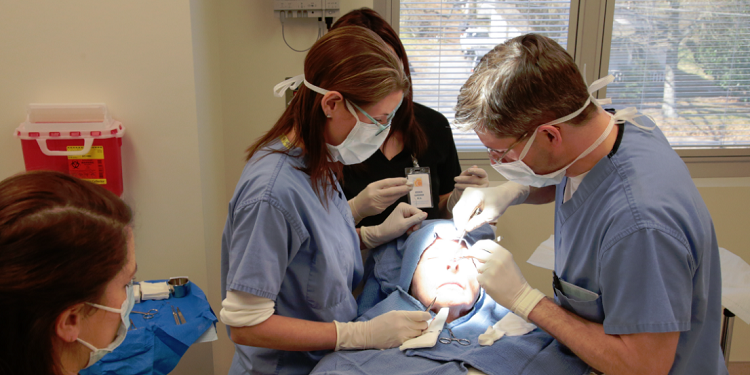What Happens During Mohs Micrographic Surgery?

Mohs micrographic surgery has advanced the treatment of skin cancer, because of its high cure rate and emphasis on tissue conservation. In fact, Mohs surgery has been successful in cases where other treatment options have failed.
So, let’s take a look at what happens during Mohs surgery, and why it has become such an important procedure in skin cancer treatment.
What is Mohs Micrographic Surgery?
Mohs surgery is a highly specialized and very precise technique that is used to treat skin cancer. It is often used to treat basal cell carcinoma, and squamous cell carcinoma.
It has become the leading treatment for cancer, because of the methodical manner in which it is performed, which helps to minimize the removal of healthy tissue. This feature makes it especially beneficial for treating cancer located in areas where it is critical to retain as much healthy tissue as possible, e.g. on the hands and feet.
Mohs micrographic surgery is named after Dr. Frederick Mohs, who first developed that procedure in the 1930’s. Since that time, it has undergone a number of modifications that have made it more accurate and effective.
What Happens During Mohs Surgery?
Mohs surgery is usually performed as an outpatient procedure under local anesthesia. The operation involves the surgical excision of the cancerous skin, which is removed not all at once, but layer by layer. A series of surgical excisions are done, in which the skin lesion is removed in thin layers.
Mohs surgery is unique, because of the technique that is used to examine the tissue once it’s removed. Each layer of tissue that is excised is color coded using a special dye that is placed along the edges. A map of the tissue is also made, so that the surgeon can see the areas that contain cancer. Mapping allows the surgeon to track and also remove the extensions of the skin cancer.
Each layer of tissue removed is immediately examined under a microscope, to identify if there are any cancer cells still remaining. If any cancer cells are seen their location is marked on the map, and then another layer of tissue is removed and the process repeated. The surgeon will continue to excise layers of tissue until there are no more cancer cells to be seen.
When all the cancerous tissue has been removed, the area is then reconstructed. The wound may be repaired with the use of a skin graft or a flap, or it may be closed with stitches. The surgeon will select the method that best preserves function, and is also aesthetically pleasing. This decision is normally made after the cancer has been completely removed, and the extent of the final wound is apparent.
Mohs surgery normally takes several hours, and it is generally impossible to predict the timeframe, because of the technique used.
Why Mohs?
Mohs surgery has a very high rate of success, and is suitable for most types of skin cancers, including more complex forms. However, it is especially beneficial for cancers that:
- Show uncontrollable growth
- Have reappeared after being treated before
- Have undefined edges
- Are located in an area where there is need to preserve healthy tissue
Benefits of Mohs Surgery
With standard excision surgery all the cancerous skin is removed at the same time, along with some healthy tissue. But with Mohs surgery, only a minimal amount of healthy skin is excised.
The tissue removed during Mohs surgery is examined by the surgeon under a microscope during the procedure, so surgeons are able to verify that all the cancer has been removed. There is therefore less likelihood that additional surgery will have to be performed, which often happens with standard excision surgery.
Since all the tissue samples are evaluated during Mohs surgery, there is much less chance of any residual cancer cells being missed. With standard excision surgery, only a percentage of the tissue is examined.
Skin cancer is a lot more common in the US than most people realize, so having a highly advanced and effective treatment like Mohs surgery, is an important weapon in the fight against this disease.
Additional Resources
Video: What is Mohs Surgery?
Infographic: Mohs Surgery by the Numbers

infographic via the American College of Mohs Surgeons
Links & Further Reading
- Learn about the evolution of Mohs surgery at SkinCancer.org
- Read the latest news about skin cancer at MD.com
- Find skin cancer health tips at MD.com
Find a Mohs Surgeon Near You
- Search for Mohs surgeons near you on the American College of Mohs Surgery website
Mohs Surgery in Atlanta
Mohs surgery is available in the greater Atlanta metro area at Skin Cancer Specialists P. C. & Aesthetic Center. Contact Dr. Mark A. Chastain today to book an appointment.



